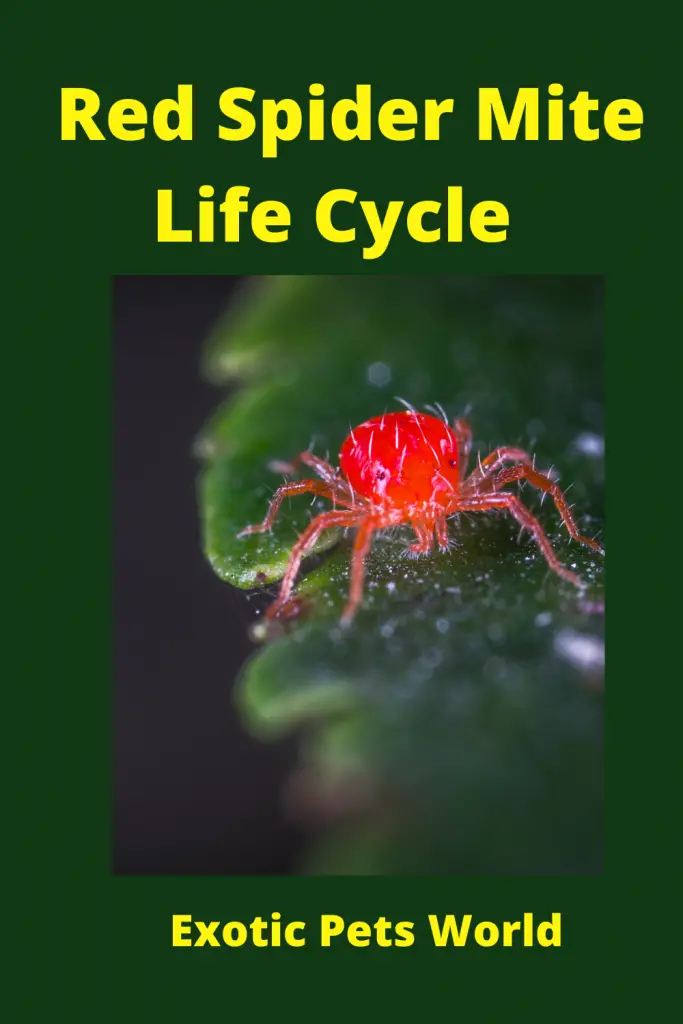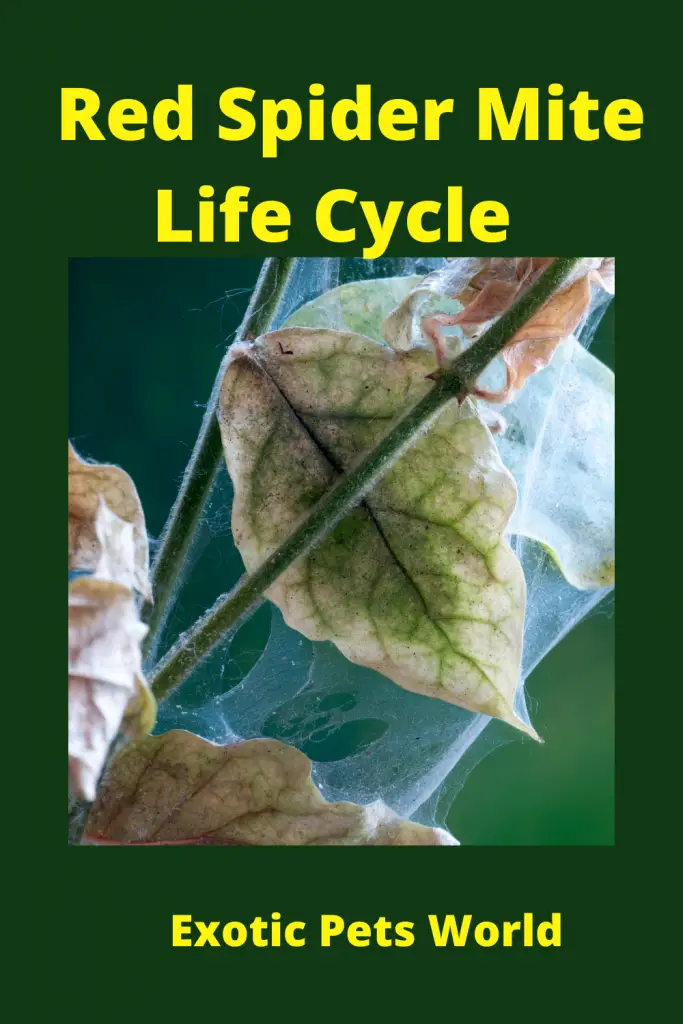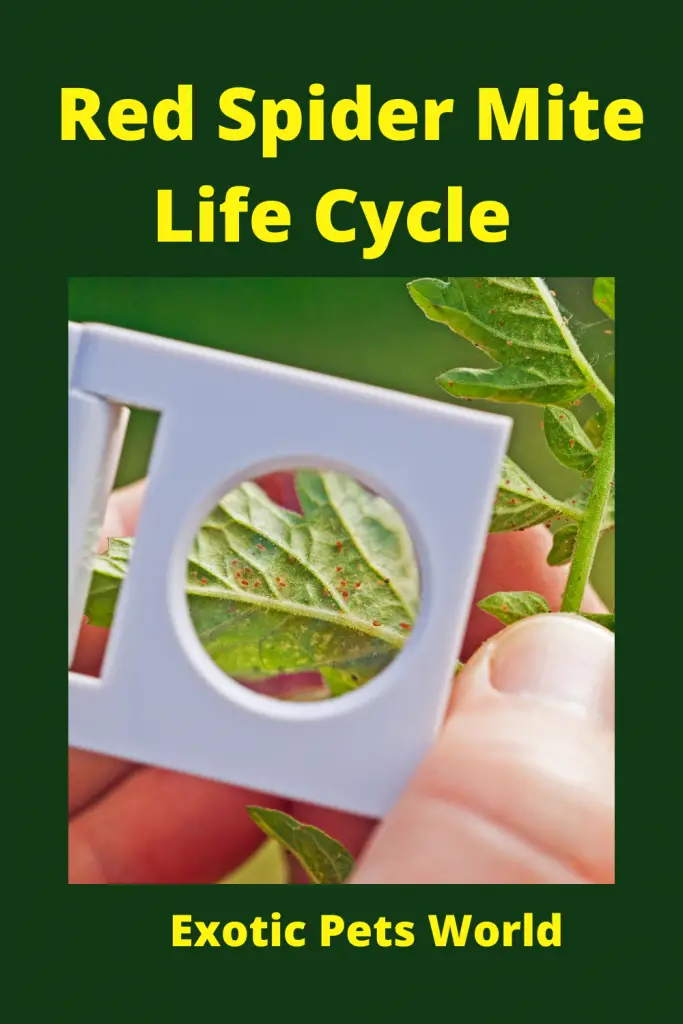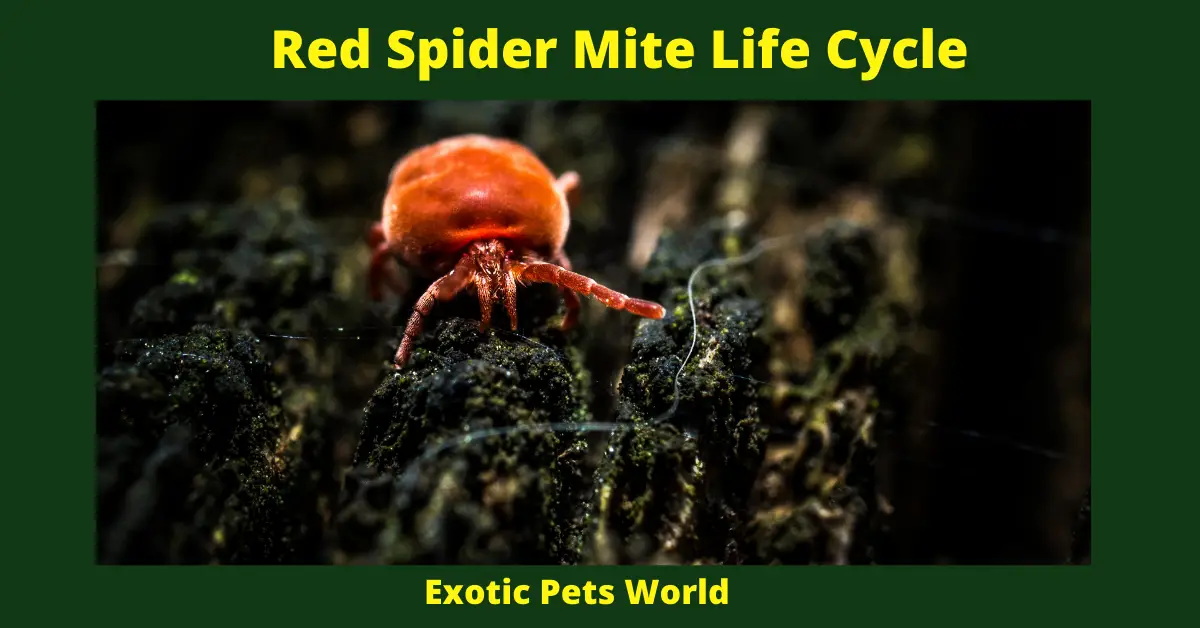Red Spider Mite Life Cycle
Spider Mite Life Cycle – The red spider mite is one of the most common pests in greenhouses. It affects a wide variety of plants, including vegetables and flowers. The red spider mite is not actually a true bug; it’s an arachnid related to ticks and spiders. They are difficult to identify because they are so tiny (less than 1/70th inch) but there are ways you can tell if you have them. We will discuss how red spider mites reproduce, what types of damage they do, and how to prevent and treat them below!
What are Red Spider Mite?
A spider mite looks small but it can be found in gardens and greenhouses. They are related to ticks and spiders, which might seem scary at first, but these tiny creatures don’t produce poison or bite humans!
Spider mites have eight legs and no antennae. These pests measure less than a ¼ inch long (about the same size as red blood cells). They can be Red, Yellow, Orange, and Brown in color. In general, there is one female spider mite for every male spider mite because females need males to fertilize their eggs. The only time females reproduce without fertilization from males is when they eat another pregnant female while still inside of her body–so it’s not too common that you’ll see many baby spider mites! The two-spotted spider mites have two black spots on their backs.
The two types of red spider mites most commonly seen by homeowners are the two-spotted spider mite and the russet spider mite.
The red spider mites we’ll be focusing on in this article are called the two-spotted red spider mite, which has a reddish tint to its body that’s visible through a magnifying glass. These little pests can go from egg to adult within one week! The only other time you see them before their adults is when females eat another pregnant female while still inside of her– so it’s not too common for people to find many baby ones.

How Long is a Spider Mite Life Cycle?
The length of the spider mite life cycle depends on the temperature. In general, red spider mites go from egg to adult in about one week when it’s between 20-25°C (68-77°F). The life cycle can take up to two weeks at 15-20°C or lower and there is no reproduction below 18º C!
The females will lay eggs every three days throughout their lifetime so if you don’t want them around for long, you’ll need to make sure they’re all killed within a few days of each other. One way to do this is with insecticides like neem oil spray which can be sprayed directly onto plants–or use strips designed specifically for pest control that are hung from branches near where spiders might congregate.
The number of eggs a female lays mite eggs will depend on her age. For example, a four-week-old spider mite might lay up to 50 eggs while an eight-week-old female can produce 100 eggs!
Once she’s had enough time for all of them to hatch and become adults, the red spider mites will die–usually in two weeks or less without food.
How long do Red Spider Mites Live?
With Food, spider mites will live for up to three weeks or more. It’s possible for them to live without food, but it takes a lot longer (generally about eight months). When red spider mites are hungry, they’ll feed on the leaves of plants and leave behind little specks that look like salt from all their droppings!
– They will eat away at the surface layers of plant tissue so leaves appear speckled with tiny brown dots called ‘salt’ or ‘spider poop’. The problem is these bugs often have many generations going at once which makes it hard for anyone treatment plan to fully control them.
How fast do Spider Mites Reproduce?
They can reproduce so fast that spider mite infestation is a common problem in greenhouses and gardens. It can be difficult to keep up with if you don’t know what signs to look for! Females lay eggs every three days throughout their lifetime–so the sooner they’re killed, the less chance there is for them to reproduce.
The most effective way of stopping spider mites from reproducing is by spraying neem oil or insecticides on plants interested in controlling pest levels. Using strips that hang near where spiders might congregate will also help provide some relief as these pests generally avoid any areas sprayed with chemicals.
Spider mites like warm weather so it’s important not only to monitor how often females are laying eggs but also when your plant needs regular watering because this could mean an increase in spider mite activity.
Where do Red Spider Mites Lay their Eggs?
Where do they lay their eggs and then what do spider mites feed on?
Spider mites lay their eggs on plants that are already weak. They like to feed on the leaves of badly watered or salt-stressed plants, so it’s important to be aware of how often these pests need water and make sure they get plenty!
One way red spider mite infestation can spread is through pets–though you don’t have much chance if your pet stays outside most of the time. The biggest risk comes from people who bring cats or dogs into a greenhouse with an active infestation where spiders might live in trees and other places nearby. Spider mites could easily hitchhike back home with them! It’s best not to go inside a greenhouse unless wearing some type of clothing that will protect against insects.
What will Eat Spider Mites? Predatory Insects
The natural predators of the adult mites are the big-eyed bug and soldier beetle. Also, the spider mite eggs are attacked by predatory thrips.
Predatory thrips are a very important part of the red spider mite life cycle. They feed on eggs and larvae in their early stage, but as it ages predatory thrips will also eat adult insects too.
What is a thrip?
Thrips are a type of small flying insect that is related to the mosquito. They’re often found in greenhouses and gardens, but thrips will also feed on red spider mite eggs while they’re still in their early stage. Once it becomes an adult, predatory thrips may eat other insects too!
How do you get Rid of Spider Mites Naturally?
If you want to kill spider mites naturally, you’ll want to use neem oil or insecticides that contain pyrethrins. Sprays with these chemicals will kill the spider mites on contact and also destroy their eggs, preventing new infestations from happening while killing off any already present insects too!
If you prefer a natural alternative, try spraying horticultural oils into plants in order to suffocate them. If this is done correctly it should not disrupt plant growth because they are generally safe for both humans and animals so long as they’re used properly–but don’t spray if there’s rain coming soon after application!
Spraying water onto leaves every week can help control red spider mite populations by dehydrating them (though be aware of how often your plant needs water or this could cause an increase in spider mite activity).
Pesticides you might use to kill predatory mites are insecticides that have pyrethrins in them. These are chemicals that will kill the spider mites on contact and also destroy their eggs, preventing new infestations from happening while killing off any already present insects too!
Insecticidal soaps can be used soap is another option. It’s a soap solution that kills insects on contact and doesn’t leave any harmful residue behind, but it also destroys the eggs of spider mites so new infestations can’t happen while killing off the ones already present too!

What Smell do Spider Predatory Mites Hate?
The Odors that repel predatory mites are lemon oil, peppermint oil, and eucalyptus.
Plants that you can plant to help with spider mite populations are lavender, catnip, and peppermint because they have been shown to repel spider mites.
How do you Scout Spider Mites in Corn?
You are looking for infected plants in corn by looking for webbing and insect damage. Looking on the bottom of leaves for discoloration and webbing.
Some other plants that are susceptible to spider mites include:
– tomatoes – roses – asparagus
– spinach – beans (dry)
– cucumbers – squash
Spider Mite Life Cycle Summary: Spider mites, also known as red spider mites, can take over your garden quickly if you’re not paying attention! The first step in getting rid of them naturally is to identify what they look like so you’ll know which methods will work best on the life cycle stage they’re currently at. When it comes time to kill predatory mites with pesticides or natural remedies, make sure you get something designed specifically for their type–and protect yourself from bites while doing this
How do you get Rid of Corn Mites?
The way you can use to get rid of adult spider mites in corn is to use a pesticide or natural remedy.
If you want to kill spider mites on corn with pesticides, some options are insecticides that have pyrethrins in them. They will work in contact and also destroy their eggs so new infestations can’t happen while killing off any already present insects too!
Insecticidal soap is another option–it’s a soap solution that kills the bugs on contact without leaving any harmful residue behind but it also destroys the eggs of spider mites so new infestations can’t happen while killing those already there too!
the Predator insects that feed on spider mites are:
– lacewings – ladybugs
– minute pirate bugs – damsel bugs
Birds that find Spider Mites Tasty include:
– starlings – robins
Will Spider Mites Ruin my Crop?
The extent of the damage if spider mites attack your crop depends on the plant, but you should always take care to protect your plants from them.
Spider mites are most common in cucumber and squash crops–though they can infest tomatoes as well.
In general, there will be damage if these pests have a chance to chew away at leaves for long enough or if something else damages some of the areas where spider mite populations thrive.
If this happens then it could cause major issues with photosynthesis that leads to less fruit production and even stunted growth!
The extent of damage is also dependent on factors like how often the plant needs water (if too much watering causes an increase in spider mite activity) and what type of predators might show up while you’re not looking.

Can I Control Spider Mites?
Spider mite damage can be controlled by
- Pesticides
- Natural Repellents
- Water
- Insecticidal Soaps
- Predators
- Dusting with Powders
How do I know if I have Spider Mites?
You can tell if you have spider mites by
– Webbing
– Damage to leaves, petals, or fruit on the plant #This is where you can say that some signs are visible damage and others are not. You can also mention how spider mites might look different at various life cycle stages!
If you don’t see any of these things then it’s possible there may be another problem with your plants–so always check for other possibilities before assuming they’ve been infested by red spiders.
They normally feed on the bottom side of the leaves.
Can I see Spider Mites with the Naked Eye?
No, but they can be seen with the microscope.
Spider mite eggs are hard to spot without a magnifying glass and even then it’s difficult because of their size–they’re usually yellow or white!
What is the life cycle stage of spider mites? Spider Mites go through four stages in their lifecycle which are as follows: Egg, Nymph (or larva), Adult and finally cocooning where females lay eggs inside plants’ leaves until winter when
How do you get Rid of Spider Mites and Aphids on Ornamental Plants?
Thes ways can help you control spider mite problems inside the house:
– soapy water spray, a good option for spider mites on indoor plants. It can kill adult and egg stages of the pests–but it doesn’t work well against aphids. Be careful not to use too much because this is often toxic to other insects in your home!
If you’re looking for something that will get rid of both then try spraying with insecticidal soap mixed with an oil such as dishwashing liquid or vegetable oil. This should be enough to destroy all life cycles of these destructive creatures at once! Just make sure they don’t do any damage while wet though like leaves becoming sticky or drooping from their coating before drying out again if needed given how natural oils might coat them.

Home Remedies
– Neem oil, a natural pesticide that can be used to kill both spider mites and aphids with the help of a little dish soap.
– Tobacco water: tobacco is also an effective way of getting rid of these pests because they naturally avoid it so as soon as you spray this on your plants or put some in pots then they will stay away! Just make sure not to overdo it though–too much nicotine could cause plant damage if leaves get wet or stuck together from overspray.
Insecticidal powders are another option for home use–just remember that the powder must touch them directly without any barriers like wax paper between otherwise those pesky bugs might just absorb all the powder’s effectiveness before dying off.
Final Thoughts
Conclusion paragraph: Spider mites are tiny, eight-legged creatures that live in the soil and feed on plant leaves. Red spider mites cause extensive damage to crops by feeding on their plants’ cells and sucking out nutrients from them. The most common red spider mite is called Tetranychus urticae (also known as Oligonychus telesphori). These pests can be found throughout temperate regions of the world – including North America, Europe, China, Japan and Australia – but they mostly inhabit greenhouses or other similar environments where conditions suit them best. If you suspect you have a problem with these pesky insects then we’ve got some tips for getting rid of them!

This will be a excellent website, will you be interested in doing an interview about just how you designed it? If so e-mail me!
This design is wicked! You most certainly know how to keep a reader entertained. Between your wit and your videos, I was almost moved to start my own blog (well, almost…HaHa!) Fantastic job. I really enjoyed what you had to say, and more than that, how you presented it. Too cool!
The very root of your writing whilst appearing agreeable originally, did not sit well with me after some time. Someplace within the paragraphs you actually managed to make me a believer but only for a short while. I still have got a problem with your leaps in logic and one might do well to fill in all those breaks. In the event you can accomplish that, I will undoubtedly end up being fascinated.
Hey there, I think your site might be having browser compatibility issues. When I look at your website in Safari, it looks fine but when opening in Internet Explorer, it has some overlapping. I just wanted to give you a quick heads up! Other then that, superb blog!
Howdy would you mind letting me know which web host you’re working with? I’ve loaded your blog in 3 completely different web browsers and I must say this blog loads a lot quicker then most. Can you recommend a good web hosting provider at a reasonable price? Thank you, I appreciate it!
When I originally commented I clicked the “Notify me when new comments are added” checkbox and now each time a comment is added I get several emails with the same comment. Is there any way you can remove me from that service? Thanks a lot!
You have observed very interesting details ! ps nice website .
Hey there would you mind letting me know which hosting company you’re working with? I’ve loaded your blog in 3 different web browsers and I must say this blog loads a lot quicker then most. Can you suggest a good hosting provider at a honest price? Many thanks, I appreciate it!
Thanks for the sensible critique. Me & my neighbor were just preparing to do a little research about this. We got a grab a book from our area library but I think I learned more from this post. I’m very glad to see such excellent information being shared freely out there.
Hmm is anyone else experiencing problems with the images on this blog loading? I’m trying to find out if its a problem on my end or if it’s the blog. Any responses would be greatly appreciated.
When I initially commented I clicked the “Notify me when new comments are added” checkbox and now each time a comment is added I get three emails with the same comment. Is there any way you can remove people from that service? Bless you!
Hi there! I’m at work browsing your blog from my new iphone! Just wanted to say I love reading through your blog and look forward to all your posts! Keep up the fantastic work!
Very great post. I just stumbled upon your blog and wished to mention that I’ve truly enjoyed browsing your blog posts. After all I抣l be subscribing on your feed and I’m hoping you write once more soon!
Oh my goodness! Amazing article dude! Thank you, However I am going through difficulties with your RSS. I don’t understand the reason why I can’t subscribe to it. Is there anyone else having similar RSS problems? Anyone who knows the answer can you kindly respond? Thanks!!
[url=https://isynthroid.com/]synthroid 137 mcg[/url]
Cheapest private proxies – rates only $0.15 per proxy! Buy today and get 50 discount for the proxy offer – DreamProxies.com